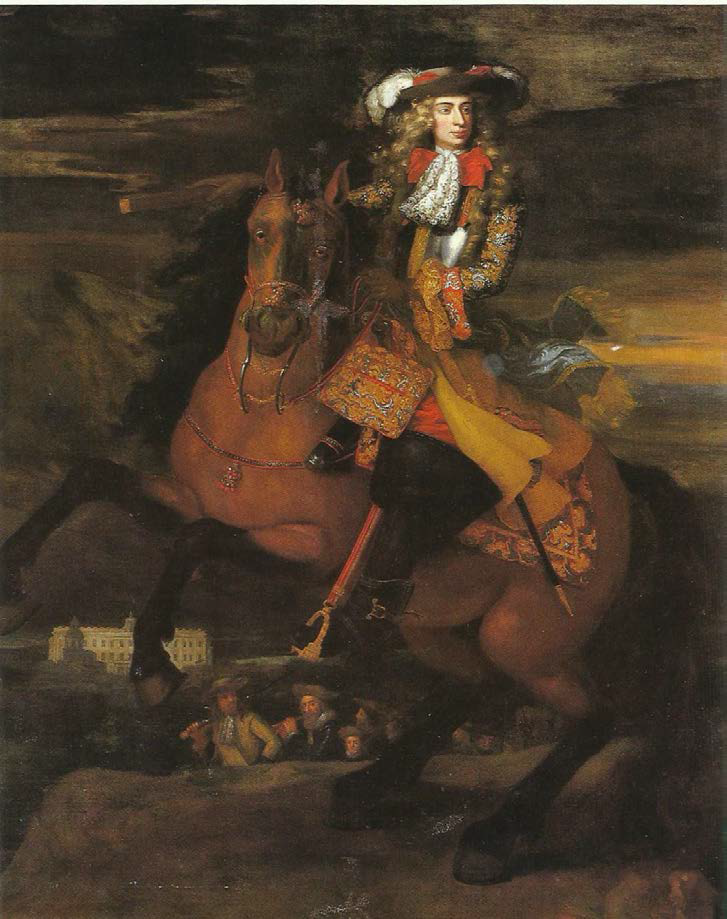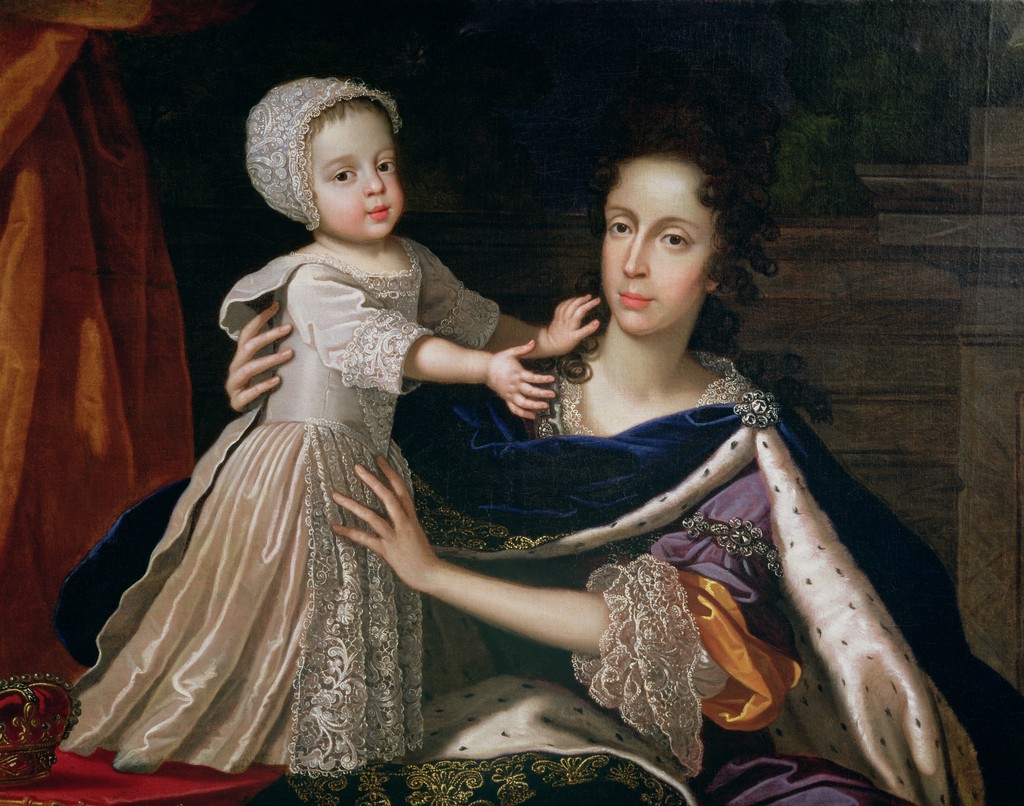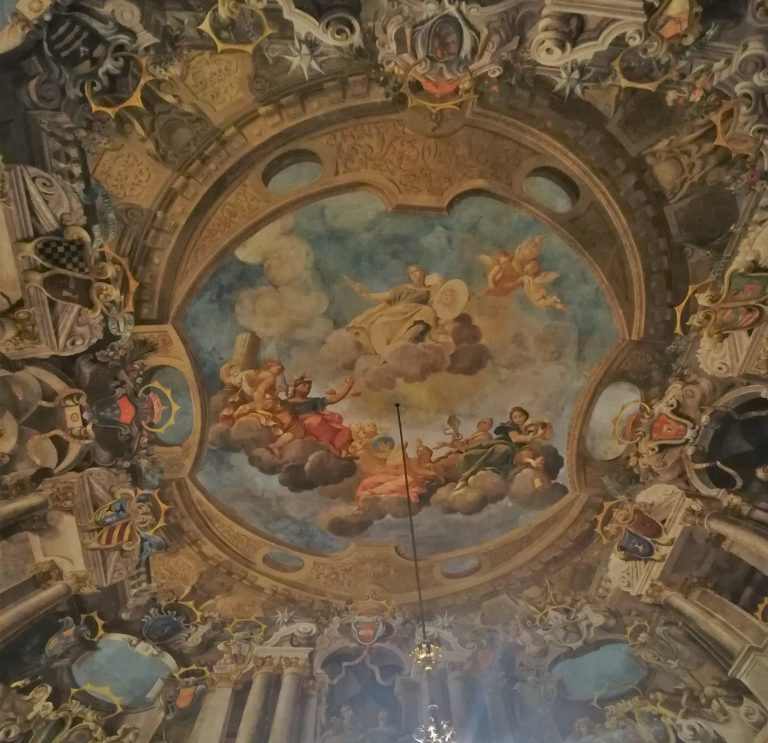The Life
Francesco was born on 6 March 1660 to Alfonso IV and Laura Martinozzi, the niece of the powerful Cardinal Mazzarino. Only two years later his father died prematurely, leaving his mother to assume the regency of the Duchy on behalf of her son, assisted by the Duke’s brothers, Cesare and Cardinal Rinaldo, and ministers Graziani and Gatti.
From early childhood, Francesco was surrounded by a large group of doctors to constantly monitor the development of his delicate health. In the meantime, the Duchess, driven by her strong religiousness, chose to entrust her son’s education to mediocre ecclesiastical instructors, contrary to the court tradition.
Due to the marriage of her daughter Maria Beatrice to the Duke of York in 1673, the Duchess left for England, leaving 13-year-old Francesco in Modena surrounded by her ministers and princes Luigi, Foresto and Cesare Ignazio, cousins not much older than him and heirs to a collateral line of the Este family.
In particular, it was Cesare Ignazio, Marquis of Montecchio, who played a key role in Francesco’s emancipation, even managing to control his naive cousin and influence his decisions. Part of Cesare Ignazio’s worldly education had in fact taken place at Versailles and on his return to the small and austere Modena, his experience at the French court led him to ambitious projects. He offered Francesco his help in governing the state and established a bond of trust with him, conquering more and more decision-making autonomy and granting the future duke the privilege of attending only to his cultural passions. It was easy for him to subjugate Francesco and, despite the negative judgment reported by Ludovico Antonio Muratori, in reality Cesare Ignazio was an able politician, endowed with intelligence and obstinacy, qualities that compensated for Francesco II’s lack of personality.
With these conditions, on 6 March 1674, his fourteenth birthday, Francesco assumed the government of the Duchy, effectively deposing his mother who had returned to Modena only the previous day and leaving her a marginal role. Accepting the will of her son who had become Duke Francesco II d’Este, Laura left Modena and, driven by her religious faith, ended her Life in Rome where she died in 1688. After the period of moral and economic austerity imposed by the Duchess, Francesco II once again allowed festivals, jousts, shows and concerts to take place, finding widespread approval among the people exhausted by the bigoted restrictions they had suffered.
A shared government, the alliance with France and the question of Guastalla
The influence of the figure of Cesare Ignazio was immediately evident, both within and outside the court: not only he did personally the most important public acts, but he was always the person of reference for ambassadors and not the duke. In December 1674 he was appointed ‘general-in-chief and director of all chamber rents’ through which he could firmly hold the reins of the Duchy in his own hands. In the meantime, the Duke dedicated himself to his passion for art and culture, spending most of his time in the splendid Palace of Sassuolo, returning to Modena only on the occasion of Council meetings, when his presence was necessary to validate his cousin’s decisions.

In the meantime, episodes related to the progressive deterioration of relations with France increased, among which, perhaps the most important, was the issue concerning the succession of Guastalla, after the heirless death of Duke Ferrante III Gonzaga in 1678. The strategic position of the city, on the right bank of the Po between Mantua and Modena, immediately caught the interest of the two neighbours, and in favour of the Este family was the close relationship with Ferrante’s widow, Margherita, Francesco II’s sister. Although the case of Guastalla was purely a local problem and dealt with the fate of a small Duchy, the other European states also took sides, driven by their interest in the future prospects concerning Mantua and Monferrato: the Emperor supported the position of Mantua, whose troops had already invaded Guastalla, as did Spain, which favoured the late Duke’s brother, Vespasiano Gonzaga earl of Paredes. France should therefore have supported the Este family in their reclamation of the territory but, secretly, negotiated instead with the Duke of Mantua in exchange for the cession of the fortress of Casale, and this agreement, signed in July 1681, highlighted the inconsistency of the Franco-Este alliance.
In fact, Cesare Ignazio’s role in the Este government was not appreciated by Louis XIV, who recognised him as the author of the Duchy’s hostility towards him, even going so far as to personally request his removal. Even his sister Maria Beatrice, who had become Queen of England in 1685, pressed her brother to exclude his cousin from the government by accepting the requests of the King of France, but Francesco did not submit to external demands, reaffirming his independence in government choices. The other states, however, viewed the situation in Modena with concern, fearing the possibility of a conflict. Soon even the duke clearly considered his own position and the importance of the economic and military forces of the Duchy compared to the French power, arriving at the most logical and opportune decision: on 23 June 1685 Cesare Ignazio left the court to retire to Faenza. For the first time Francesco II found himself alone at the helm of the State and a few weeks after his cousin’s departure he complained to his sister Maria Beatrice how much effort and commitment it cost him to govern, fearing that this task could aggravate his precarious health. The Queen of England, knowing her brother’s limitations, did her best to convince Louis XIV to authorise his return to Modena and, thanks to the importance of her role, the Christian queen, chosen and desired by the King of France himself, obtained the return of Cesare Ignazio to the Duchy in the autumn of 1686. Maria Beatrice’s action also brought the title of cardinal to her uncle Rinaldo, who held it from 1686 to 1695.
Apparently relations between the Duchy and France had returned to normality, but resentment and mutual distrust still smouldered under the ashes. Moreover, the French protection and imposed rules had become too stringent for the Duke, who began to see the alliance with the Habsburgs as a way out.
The Glorious English Revolution (1688)
The Second English Revolution brought William d’Orange to the English throne and consequently caused the deposition and exile of the English royals, James Stuart and Maria Beatrice d’Este. Francesco II was not only apprehensive about the fate of his sister and nephew Giacomo, but also found himself deprived of his most important ally. The Duke, albeit to no avail, urged the Pope to rise up against the Protestants and to restore James II Stuart to the English throne in an attempt to protect his sister who had fled with their son. Even after her husband’s death in 1701, Maria Beatrice tried several times to take over the regency of England in her son’s name, but every attempt was in vain, as in 1717 the young Giacomo III finally renounced any possible claim. The following year, Maria Beatrice d’Este, the last Catholic queen of England, died in Saint Germain en Laye in France.

The political situation
The general political situation was very delicate: the changes brought about by the second English revolution, the increasing isolation of France and the advance of the Habsburgs, after the final expulsion of the Turks, imposed prudence and the usual position of neutrality on the Este family. For this reason, in 1689 the Duke forbade Cardinal Rinaldo to accept the prestigious appointment as ‘protector of France’ to the Holy See, received from the King of France. In the meantime, from 1683 the demands of Vienna to contribute to the costs of war had begun: until 1690 they were resolutely rejected, but the following year the Habsburgs imposed on the Este family the maintenance of winter quarters (food, wood and money) for some imperial regiments stationed in the Duchy.

Even within his own court, Francesco II had reasons to be disturbed, mainly due to the behaviour of Cesare Ignazio’s brothers: Foresto was constantly in conflict with him, and Luigi, appointed governor of Reggio, caused scandal and discontent among the Reggio nobility due to the conduct of his mistress Anna Maria Cagnolati.
Francesco’s delay in concluding his marriage agreement also contributed to this complicated situation: a slowness attributable both to his precarious health and to Cesare Ignazio’s desire to procrastinate the arrival of a Duchess who could have obscured his personal power. After many failed negotiations, the need for a union that would guarantee the succession prevailed rather than an agreement that would bring great economic or territorial advantages to the Duchy. Therefore, in 1690, negotiations for the marriage with Margherita Farnese, daughter of Ranuccio II Duke of Parma, were concluded, which took place on 14 July 1692, after the necessary papal dispensation due to the relativeship between the two newlyweds. Even on the occasion of his marriage, celebrated in the nearby city of Parma, Francesco II had himself represented by Cesare Ignazio, and, contrary to the indications and hopes of his doctor, after the wedding the Duke’s health did not improve at all, nor did the expected heir arrive.
To all this was added the heavy political pressure from Austria, which forced Francesco to make huge outlays, reducing the public finances of the Duchy, despite the heavy sacrifices imposed on both the population and the court itself. The request to reduce taxes is dated 1693, but the tension caused by the now dramatic financial situation worsened the health of the Duke who, having recovered from a serious episode of illness in April 1694, died a few months later, on 6 September 1694, at the age of 34. The solemn funeral was celebrated in Modena on 9 March 1695 in the Church of Sant’Agostino.
Francesco’s death also sanctioned the end of the power of Cesare Ignazio, who would leave the Modena political scene until, having made peace with Duke Rinaldo, he was granted the appointment as governor of Reggio, the city where he died in 1714.
The diarchy that had characterised Francesco II’s government, although difficult to implement and much criticised, was probably the only viable way to govern the Duchy in the absence of a sovereign capable of acting with determination and audacity. Cesare Ignazio must, in fact, be credited with supporting and flanking Francesco, who was otherwise unable to rule alone and take on the difficult responsibilities of state administration. Moreover, thanks to his political intuition, the Duchy was able to maintain a neutral position with respect to the political events of the time, managing to stay out of wartime conflicts.
Francesco II’s cultural interests
While political commitments and governmental activities were on Caesar Ignatius’ shoulders, the Duke had more time available to follow his cultural interests. Francesco, a music patron and musician himself, favoured sacred and instrumental music in particular and during his rule Modena experienced a very flourishing season as far as music was concerned. During these years, the Ducal Chapel, which hosted concerts by some of the greatest composers of his era, was renovated through continuous improvements in order to achieve ever greater performance perfection.
The musical passion was complemented by that for theatrical performances, of which the Este family had been refined patrons and promoters since the 15th century. In 1685 Francesco commissioned the construction of a small court theatre in the Ducal Palace where performances could be held that did not require large sets, such as ballets or oratories. The theatre was inaugurated on 13 March 1686 on the occasion of the celebrations for the Duke’s birthday, and the first performance to be staged was the musical drama ‘L’Eritrea overo Gl’Inganni della maschera’ to a libretto by Count Giovan Battista Rosselli Genesini.
Francesco also worked hard to arrange the Estense Library, still awaiting definitive organisation after the Devolution of Ferrara. In order to accommodate the library’s holdings, the Duke made a space available on the upper floors of the Ducal Palace and charged the various librarians of the Ducal Palace, who succeeded one another in the administration, with the task of reorganising the precious collection so that it could be used.
Since the middle of the 12th century Modena had possessed a Studium that was closed and incorporated into that of Ferrara, when the latter was the capital of the Duchy. Now that Modena was the most important city, it was necessary for it to possess the institutes for higher studies, and so it was that through an agreement with the Municipality and the Congregation of the Blessed Virgin and Saint Charles, in 1682 the Duke returned the Studium to Modena and after three years, by ducal decree, it was elevated to the status of University: this meant that the educational qualification issued was also recognised outside the borders of the Duchy. The institution found its seat in the San Carlo College.

The cultural rebirth of the city continued with the establishment in 1683 of the Accademia dei Dissonanti, the most important literary academy in Modena, founded on the initiative of the religious members of the Congregation of San Carlo and with the financial support and participation of Francesco II. Despite the transformations that have taken place over time, the institution is still present today with the title ‘Accademia Nazionale di Scienze, Lettere e Arti di Modena’ (National Academy of Science, Letters and Arts of Modena) and is housed in the beautiful Palazzo Coccapani Rango d’Aragona, and still plays an important educational, popular and cultural role for the area.
BIBLIOGRAPHY:
“Modena Capital” Luigi Amorth, Banca Popolare dell’Emilia Romagna, Poligrafico Artioli SpA, 1997
“Gli Estensi. One thousand years of history” Luciano Chiappini, Ferrara, Corbo Editori, 2001
“Gli Estensi. La corte di Modena” edited by Mauro Bini, Il Bulino edizioni d’arte, 1997
“Sono nato principe libero, tale voglio conservarmi”: Francesco II d’Este (1660-1694), Alessandro Cont, “Memorie Scientifiche, Giuridiche, Letterarie”, Accademia Nazionale di Scienze Lettere e Arti di Modena, serie VIII, 12 (2009), 2, pp. 407-459
“The Theatre of Francesco II d’Este in the Ducal Palace of Modena (1686)”. Graziella Martinelli Braglia, “Memorie Scientifiche, Giuridiche, Letterarie”, Accademia Naz. Scienze, Lettere e Arti di Modena, s. VIII, v. XIX (2016)
Treccani Bibliographical Dictionary of Italians






